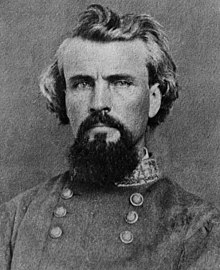Bedford Forrest
| Nathan Bedford Forrest | |
|---|---|
 |
|
| Nickname(s) | Old Bed Devil Forrest Wizard of the Saddle |
| Born |
July 13, 1821 Chapel Hill, Tennessee, U.S. |
| Died | October 29, 1877 (aged 56) Memphis, Tennessee, U.S. |
| Buried | Health Sciences Park Memphis, Tennessee, U.S. |
| Allegiance |
|
| Service/ |
|
| Years of service | 1861–1865 |
| Rank |
|
| Unit | White's Company, TN Mounted Rifles |
| Commands held | 3rd Tennessee Cavalry Forrest's Cavalry Brigade Forrest's Cavalry Division Forrest's Cavalry Corps |
| Battles/wars | |
| Relations | |
Nathan Bedford Forrest (July 13, 1821 – October 29, 1877), called Bedford Forrest in his lifetime, was a Confederate Army general during the American Civil War and an early leader of the Ku Klux Klan.
Before the war Forrest amassed a fortune as a planter, real estate investor, and slave trader. He was one of the few officers on either side to enlist as a private and be promoted to general officer and corps commander during the war. An expert cavalry leader, Forrest was given command of his own unit and established new doctrines for mobile forces, earning the nickname "The Wizard of the Saddle". Union General William Tecumseh Sherman called him "that devil Forrest" during wartime communications with Ulysses S. Grant and considered him "the most remarkable man our civil war produced on either side". Forrest is considered one of the Civil War's most brilliant tacticians. Without military education or training, he became the scourge of Grant, Sherman, and almost every other Union general who fought in Tennessee, Alabama, or Kentucky.
Forrest fought by simple rules: he maintained that "war means fighting and fighting means killing" and that the way to win was "to get there first with the most men". His cavalry, which Sherman reported in disgust "could travel one hundred miles in less time it takes ours to travel ten", secured more Union guns, horses, and supplies than any other single Confederate unit. He played pivotal roles at Fort Donelson, Shiloh, the capture of Murfreesboro, the Franklin-Nashville campaign, Brice's Crossroads, and in the pursuit and capture of Colonel Abel Streight's Raiders. His methods subsequently influenced many future generations of military strategists. After the war ended, Confederate President Jefferson Davis and General Robert E. Lee both expressed their belief that the Confederate high command had failed to use Forrest's talents fully.
...
Wikipedia
